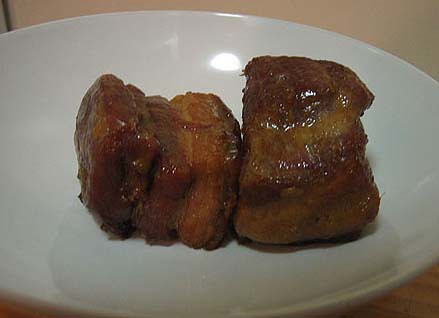For Christmas Eve dinner this year, I wanted something more substantial than just lechon kawali. Deep-frying was the only way I knew how to cook pork belly until I ate at Gramercy Tavern for the first time years ago. So of course today, I turn to Tom Colicchio’s recipe to recreate the eyes-rolling-back feeling at home. The photo below looks a lot like the one from the Filipino version but this one was heftier–you can smell and taste the concentrated flavor of the braised vegetables. The skin was chewy on this version and it’s recommended that it be discarded before serving, but the meat and the fat easily give when pierced with a fork. Patience is a virtue. This dish will make any pork lover swoon.
Ingredients:
2 pork bellies, cut into 4 large chunks
2 carrots, coarsely chopped
2 celery stalks, coarsely chopped
1 leek, white part only, trimmed and chopped
1 onion, coarsely chopped
2 garlic cloves, peeled
3 cups chicken stock
1 tbsp peanut oil
salt and pepper1. A day or a few hours before cooking, rinse the pork bellies and season with salt and pork. Air-dry for several hours and then store in freezer, each piece separated, on a plate.
2. When ready to cook, preheat oven to 350º. Heat the peanut oil in an ovenproof skillet over medium heat. Remove the pork from the freezer only when ready to cook. Add them, fat side down, to the skillet. Cook until the skin is browned, about 15 minutes. Brown the other sides for a few extra minutes then transfer to a plate.
3. Pour off all but about 2 tablespoons of fat and add the garlic, onion, carrots, celery and leek to the skillet. Cook the vegetables, stirring occasionally, until they are tender and beginning to brown, about 20 minutes. Return the pork belly to the skillet, fat side up, and add about 2 cups of stock, enough to surround but not cover the meat. Bring the stock to a simmer, then transfer the skillet to the oven.
4. Gently simmer the pork, uncovered, for 1 hour, then add another cup of stock. Continue cooking until the pork is tender enough to cut with a fork, about another hour. If necessary, keep adding stock to keep the skillet from burning.
5. Allow the pork to cool in the braising liquid. Remove the pork from the liquid, then gently lift off and discard the skin using a small knife.
6. Strain the braising liquid and discard the vegetables. Return the liquid to the skillet, bring it to a simmer and skim off the fat. Serve the pork in a shallow bowl moistened with a bit of the braising liquid.
Related post/s:
The Filipino version of this pork belly




